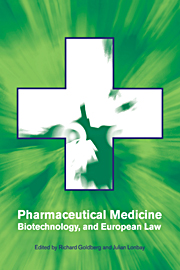Book contents
- Frontmatter
- Contents
- Notes on the contributors
- Preface
- Foreword by Francis G. Jacobs
- Editors' note
- Table of cases
- Table of treaties, European legislative instruments and national legislation
- Introduction
- Part I Free movement of goods and persons, competition and intellectual property
- Part II European drug regulation
- 5 Data protection and abridged applications for marketing authorisations in the pharmaceutical industry
- 6 The role of the European Medicines Evaluation Agency in the harmonisation of pharmaceutical regulation
- Part III Biotechnology
- Part IV Product liability and transnational health care litigation
- Index
5 - Data protection and abridged applications for marketing authorisations in the pharmaceutical industry
from Part II - European drug regulation
Published online by Cambridge University Press: 24 October 2009
- Frontmatter
- Contents
- Notes on the contributors
- Preface
- Foreword by Francis G. Jacobs
- Editors' note
- Table of cases
- Table of treaties, European legislative instruments and national legislation
- Introduction
- Part I Free movement of goods and persons, competition and intellectual property
- Part II European drug regulation
- 5 Data protection and abridged applications for marketing authorisations in the pharmaceutical industry
- 6 The role of the European Medicines Evaluation Agency in the harmonisation of pharmaceutical regulation
- Part III Biotechnology
- Part IV Product liability and transnational health care litigation
- Index
Summary
Introduction: research data in the pharmaceutical sector
Know-how is important to all businesses but particularly to the pharmaceutical industry. Industrial know-how has been described as ‘substantial technological information relating to the whole or a part of a manufacturing process or a product, or to the development thereof, which is not in the public domain…’. is implicit in the description that the information has value.
Traditionally, patents have been the main method by which the pharmaceutical industry has been able to protect the fruits of its research and the industry has devoted a lot of effort, both in the United States and in Western Europe, to successful lobbying for patent term restoration. This was seen as necessary due to the delay in being able to exploit the products derived from research as a consequence of the need for national marketing authorisations. Within the European Community, the need for marketing authorisations was harmonised in 1965 and the time taken to obtain authorisations, when added on to the time taken to develop the product in the first place and generate the requisite data relating to efficacy and safety, often left companies with insufficient time to make adequate profits before the patent expired. Such profits are required not only to recoup the cost of investment in the product in question but also to cover the significant amount of unsuccessful product development that is a fact of life for all research-based companies. In general, the industry's case for protection was accepted as being a strong one and in the European Community there came into being the principle of Supplementary Protection Certificates.
- Type
- Chapter
- Information
- Pharmaceutical Medicine, Biotechnology and European Law , pp. 93 - 136Publisher: Cambridge University PressPrint publication year: 2001
- 2
- Cited by

